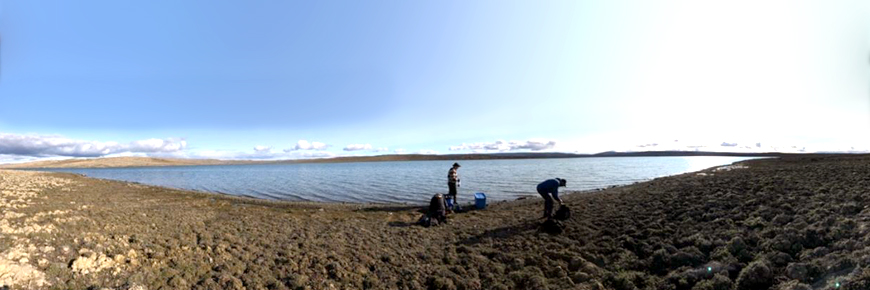
Photo: Kyra St. Pierre
Impacts of climate change and contaminant deposition on high Arctic watersheds, using Lake Hazen as a model system, led by Dr. Vincent St. Louis (University of Alberta) and Dr. Igor Lehnherr (University of Toronto-Mississauga)
Quttinirpaaq National Park
This team has been studying the impacts of climate change in the Lake Hazen watershed in Quttinirpaaq National Park since 2005. Initially the team focussed on understanding natural and human-made sources of the contaminant methyl mercury in High Arctic freshwaters. Their studies have expanded from there and they are now looking at the impacts of climate change on landscape productivity, glacier melt, permafrost thaw and changing freshwater quality in the watershed, with a continued interest in quantifying methyl mercury and other organic contaminants found in snow, ice and water.
The research objective of the 2018 field season was to sample the numerous glacial rivers and permafrost thaw streams flowing into Lake Hazen, the Ruggles River that drains Lake Hazen, as well as pond water from the tops of the Gilman and Henrietta Nesmith glaciers. Analysis of these samples will contribute to the continued building of a long-term data set, providing insight into the impacts of climate change and contaminant deposition on High-Arctic watersheds.
Methods
During the 2018 field season, water samples were taken at 28 sites in the Lake Hazen watershed. Most of these sites were at locations, accessed by helicopter, along glacier rivers between the glacier and river delta prior to flowing into Lake Hazen. At each site, water samples were collected by dipping clean bottles into the water while standing on the shoreline. Sensors were also placed in the water to instantaneously measure certain physical and chemical parameters, including water temperature, pH and concentrations of dissolved oxygen. All water samples were preserved and processed/filtered either at the sampling site or in the Quttinirpaaq/Lake Hazen Polar Field Laboratory. Back in the analytical laboratories of the University of Alberta, University of Toronto at Mississauga, University of Waterloo, and Environment and Climate Change Canada, samples were analysed for a variety of chemical compounds, including nutrients and contaminants (e.g., mercury, organic contaminants) that are thought to be rapidly melting out of glaciers due to climate warming in the High Arctic.
Discussion and results
Similar to 2017, the 2018 field season was again another cool summer that resulted in low levels of glacial melt and glacial river flow. Sampling the glacial rivers in low-melt years is just as important as sampling them in high-melt years because it provides information on year-to-year variability due to local weather conditions. As the dataset grows, year after year, researchers are better able to predict what might happen as the High Arctic continues to warm due to climate change.
Research partners
Principal researcher: Dr. Vincent St. Louis, Department of Biological Sciences, University of Alberta
Dr. Igor Lehnherr, Department of Geography, University of Toronto-Mississauga
Field research team:
Dr. Igor Lehnherr, University of Toronto-Mississauga
Kyra St.Pierre, Ph.D Student, University of Alberta
Jessica Serbu, M.Sc. Student, University of Alberta
Danielle Lemire, M.Sc. Student, University of Toronto-Mississauga
Stephanie Varty, M.Sc. University of Toronto-Mississauga
For more information on Dr. Vincent St. Louis and Dr. Igor Lehnherr’s research, see their recently launched website.
The recently released Integrated Regional Impact Study (IRIS) on the Eastern Arctic includes a chapter on the state of freshwater and glacier environments in that region. The report includes information on the studies conducted by the team mentioned above.
- Date modified :